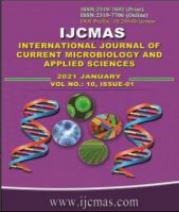


 National Academy of Agricultural Sciences (NAAS)
National Academy of Agricultural Sciences (NAAS)

|
PRINT ISSN : 2319-7692
Online ISSN : 2319-7706 Issues : 12 per year Publisher : Excellent Publishers Email : editorijcmas@gmail.com / submit@ijcmas.com Editor-in-chief: Dr.M.Prakash Index Copernicus ICV 2018: 95.39 NAAS RATING 2020: 5.38 |
With a view to suggest suitable land and water resource management measures in a degraded micro-watershed, land capability class map of a micro-watershed, falling in upper catchment of Dwarakeswar river, Chotanagpur plateau was prepared in Geographic Information System (GIS) environment by generating and integrating various thematic maps. The generated and integrated thematic maps of watershed using GIS included land use/cover, soil slope, drainage network, soil depth, soil texture and erosion status, etc. Based on the integrated land capability class map of the watershed, four land forms viz., upland -class VI, midland -class IV/III, low land - class III and valley Bohal-class II were found. 78% of total area of watershed was under class III, which is mostly mono-cropped agriculture land, while 15% of the area of watershed, which is wasteland was found be under class IV. The area under land class II comprised of 4% of total area of watershed in which double cropping is practiced. The land class of uplands was found to be VI, which comprised of 3 % of total area of watershed. Finally, based on the land class map, a package of soil and water conservation measures were suggested that can be taken up for land and water resource management with local people active participation.
 |
 |
 |
 |
 |